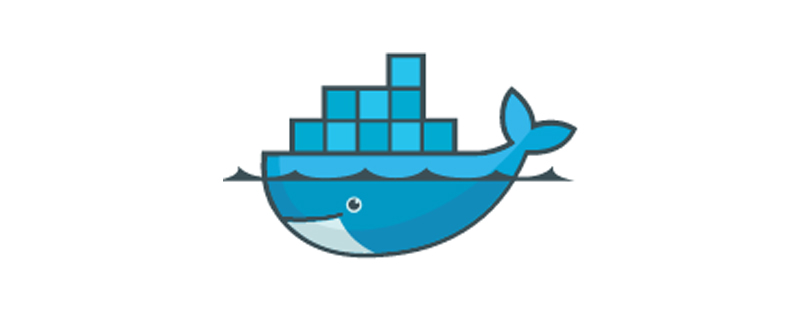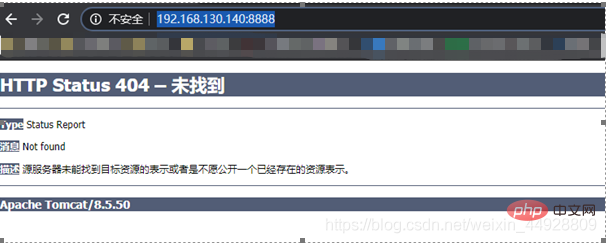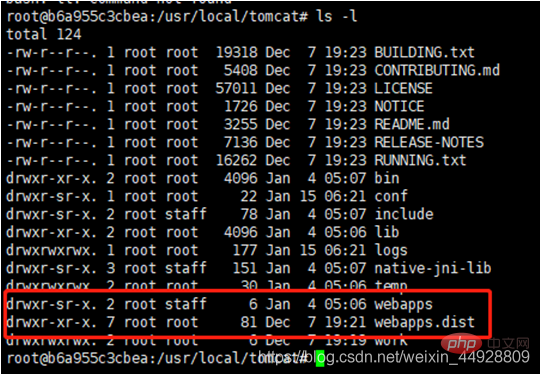What should I do if Docker fails to install Tomact?
Solution to unsuccessful docker installation of tomact: 1. Use the "docker exec -it b6a955c3cbea /bin/bash" command to enter the tomcat directory; 2. Delete webapps and rename webapps.dist to webapps. Can.

The operating environment of this article: ubuntu 18.04 system, Docker 20.10.11&&Apache Tomcat version 8.5.50, Dell G3 computer.
What should I do if Docker fails to install Tomact?
404 after docker installation tomcat starts
Install the latest on docker Tomcat starts, and a 404 error is reported when accessing tomcat 
Use the docker exec -it b6a955c3cbea /bin/bash command to enter the tomcat directory and view the directory information: 

Found that webapps is empty and tomcat’s default project resources are all in the webapps.dist folder
Delete webapps and rename webapps.dist to webapps
Problem Solving
##Install the latest tomcat startup on docker, access tomcat report 404 error 
Use the docker exec -it b6a955c3cbea /bin/bash command to enter the tomcat directory and view the directory information: 
 Found that webapps is empty, and tomcat’s default project resources are all in the webapps.dist folder
Found that webapps is empty, and tomcat’s default project resources are all in the webapps.dist folder
Delete webapps and rename webapps.dist to webapps
Problem Solve
Recommended learning: "Docker Video Tutorial"
The above is the detailed content of What should I do if Docker fails to install Tomact?. For more information, please follow other related articles on the PHP Chinese website!

Hot AI Tools

Undresser.AI Undress
AI-powered app for creating realistic nude photos

AI Clothes Remover
Online AI tool for removing clothes from photos.

Undress AI Tool
Undress images for free

Clothoff.io
AI clothes remover

AI Hentai Generator
Generate AI Hentai for free.

Hot Article

Hot Tools

Notepad++7.3.1
Easy-to-use and free code editor

SublimeText3 Chinese version
Chinese version, very easy to use

Zend Studio 13.0.1
Powerful PHP integrated development environment

Dreamweaver CS6
Visual web development tools

SublimeText3 Mac version
God-level code editing software (SublimeText3)

Hot Topics
 1378
1378
 52
52
 CentOS Containerization with Docker: Deploying and Managing Applications
Apr 03, 2025 am 12:08 AM
CentOS Containerization with Docker: Deploying and Managing Applications
Apr 03, 2025 am 12:08 AM
Using Docker to containerize, deploy and manage applications on CentOS can be achieved through the following steps: 1. Install Docker, use the yum command to install and start the Docker service. 2. Manage Docker images and containers, obtain images through DockerHub and customize images using Dockerfile. 3. Use DockerCompose to manage multi-container applications and define services through YAML files. 4. Deploy the application, use the dockerpull and dockerrun commands to pull and run the container from DockerHub. 5. Carry out advanced management and deploy complex applications using Docker networks and volumes. Through these steps, you can make full use of D
 Docker Interview Questions: Ace Your DevOps Engineering Interview
Apr 06, 2025 am 12:01 AM
Docker Interview Questions: Ace Your DevOps Engineering Interview
Apr 06, 2025 am 12:01 AM
Docker is a must-have skill for DevOps engineers. 1.Docker is an open source containerized platform that achieves isolation and portability by packaging applications and their dependencies into containers. 2. Docker works with namespaces, control groups and federated file systems. 3. Basic usage includes creating, running and managing containers. 4. Advanced usage includes using DockerCompose to manage multi-container applications. 5. Common errors include container failure, port mapping problems, and data persistence problems. Debugging skills include viewing logs, entering containers, and viewing detailed information. 6. Performance optimization and best practices include image optimization, resource constraints, network optimization and best practices for using Dockerfile.
 Yii with Docker: Containerizing and Deploying Your Applications
Apr 02, 2025 pm 02:13 PM
Yii with Docker: Containerizing and Deploying Your Applications
Apr 02, 2025 pm 02:13 PM
The steps to containerize and deploy Yii applications using Docker include: 1. Create a Dockerfile and define the image building process; 2. Use DockerCompose to launch Yii applications and MySQL database; 3. Optimize image size and performance. This involves not only specific technical operations, but also understanding the working principles and best practices of Dockerfile to ensure efficient and reliable deployment.
 Docker Volumes: Managing Persistent Data in Containers
Apr 04, 2025 am 12:19 AM
Docker Volumes: Managing Persistent Data in Containers
Apr 04, 2025 am 12:19 AM
DockerVolumes ensures that data remains safe when containers are restarted, deleted, or migrated. 1. Create Volume: dockervolumecreatemydata. 2. Run the container and mount Volume: dockerrun-it-vmydata:/app/dataubuntubash. 3. Advanced usage includes data sharing and backup.
 How to view Redis version
Apr 10, 2025 pm 01:33 PM
How to view Redis version
Apr 10, 2025 pm 01:33 PM
The Redis version can be viewed by: Run the INFO command using the redis-cli command line tool to view the redis_version field. Use administrative tools such as RedisInsight to view version information. For statically compiled Redis or redis-cli not installed, view the version information of the service configuration file or executable file.
 Docker Troubleshooting: Diagnosing and Resolving Common Issues
Apr 07, 2025 am 12:15 AM
Docker Troubleshooting: Diagnosing and Resolving Common Issues
Apr 07, 2025 am 12:15 AM
Docker FAQs can be diagnosed and solved through the following steps: 1. View container status and logs, 2. Check network configuration, 3. Ensure that the volume mounts correctly. Through these methods, problems in Docker can be quickly located and fixed, improving system stability and performance.
 Docker with Kubernetes: Container Orchestration for Enterprise Applications
Apr 08, 2025 am 12:07 AM
Docker with Kubernetes: Container Orchestration for Enterprise Applications
Apr 08, 2025 am 12:07 AM
How to use Docker and Kubernetes to perform container orchestration of enterprise applications? Implement it through the following steps: Create a Docker image and push it to DockerHub. Create Deployment and Service in Kubernetes to deploy applications. Use Ingress to manage external access. Apply performance optimization and best practices such as multi-stage construction and resource constraints.
 Using Docker with Linux: A Comprehensive Guide
Apr 12, 2025 am 12:07 AM
Using Docker with Linux: A Comprehensive Guide
Apr 12, 2025 am 12:07 AM
Using Docker on Linux can improve development and deployment efficiency. 1. Install Docker: Use scripts to install Docker on Ubuntu. 2. Verify the installation: Run sudodockerrunhello-world. 3. Basic usage: Create an Nginx container dockerrun-namemy-nginx-p8080:80-dnginx. 4. Advanced usage: Create a custom image, build and run using Dockerfile. 5. Optimization and Best Practices: Follow best practices for writing Dockerfiles using multi-stage builds and DockerCompose.




